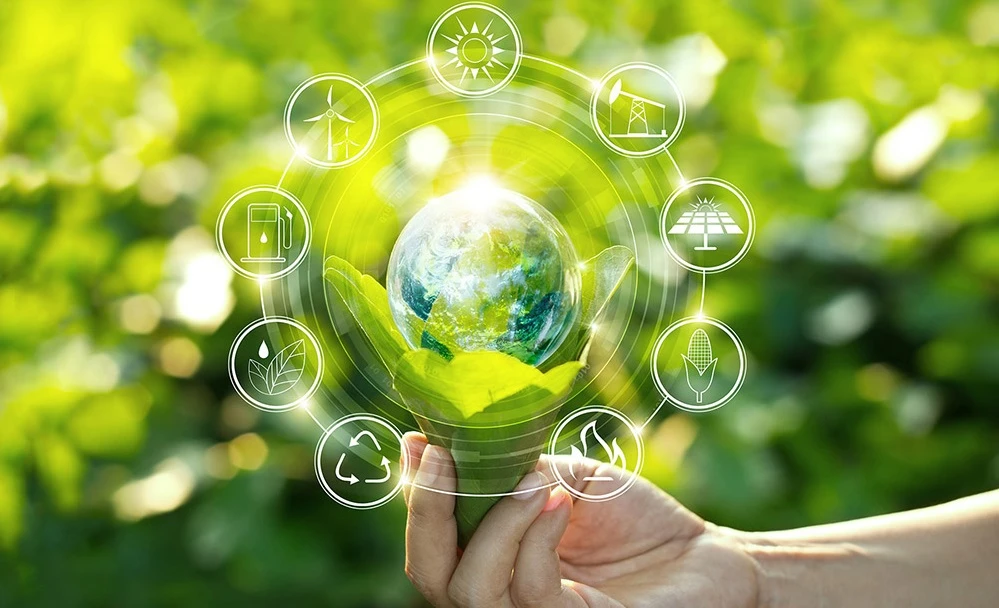
However, he highlighted the crucial necessity for catalysts to propel substantial growth. According to Dr. KHƯƠNG, Vietnam must concurrently advance the digital economy alongside the green economy, with both sharing common objectives and providing mutual support to achieve a transformative breakthrough.
JOURNALIST: - The green growth model is gaining global traction, and Vietnam can't afford to be left behind. What are your thoughts on Vietnam's potential and challenges in embracing this transition?
Prof. Dr. VŨ MINH KHƯƠNG: - Many countries have successfully adopted the green growth model, driving impressive socioeconomic development. If Vietnam clings to the old model focused solely on expansion without prioritizing productivity, it will fall behind the rest of the world. For instance, our reliance on cheap labor is fading, and major cities like Hanoi and Ho Chi Minh City struggle with congestion and pollution, deterring potential investors.
However, Vietnam has a strong foundation for green growth. Our free trade agreements, for example, offer significant advantage. But our major trading partners, like the US, Japan, Korea, and the EU, increasingly prioritize green practices and products. Failure to adapt could cost us these crucial customers. Considering this reality, I firmly believe that green growth is the necessary and urgent path for Vietnam to stay competitive on the global stage.
Looking at the positives, strong political commitment from both central and local leadership is evident. Our policies are also consistent, which impressed many foreign officials and experts I've interacted with. Beyond leadership, we have valuable resources, including both skilled workforce and capital. Our commitment attracts significant international support, both financial and technical, further boosting our capabilities. This also attracts high-quality foreign direct investment (FDI) focused on key areas within the regional and global production supply chain.
Despite these advantages, challenges remain. The biggest hurdle is the lack of a central "architect" to design and implement a solid foundation for green growth. This results in slow and disjointed implementation efforts. Additionally, Vietnam's legal system, with its complexities, can disincentivize both investors and businesses looking to pursue sustainable practices.
- You previously mentioned the importance of a digital economy for Vietnam. Now, the focus is shifting towards a green economic model. In your opinion, sir, which of these models should we prioritize for green growth?
- I believe both models are crucial and groundbreaking pillars for Vietnam's current economic growth. They share the same goal: driving sustainable economic growth and development. Vietnam needs to actively embrace and build upon both of these pillars.
Think of it like taking both offense and defense. The "offensive" strategy is seizing the incredible opportunity presented by the 4.0 revolution. This revolution offers a rare chance for developing countries like Vietnam to leapfrog in their development process. We need to actively participate and leverage this opportunity for advancement.
The "defensive" aspect focuses on ensuring Vietnam possesses the necessary tools and platforms to remain relevant in the changing economic landscape. This involves equipping ourselves with the right skills, infrastructure, and technologies to stay compatible with the green model.
In short, Vietnam shouldn't choose between digital and green economies. We need to pursue both simultaneously, both to drive growth and ensure we're not left behind in the global shift towards sustainable development.
- Vietnam wants to embrace green growth for sustainable development, but what are the key solutions needed?
- As I mentioned earlier, our biggest roadblock is the lack of a central "architect" to design and implement a robust framework for green growth. This leads to slow and uncoordinated action. To overcome this, Vietnam needs to find this crucial "architect." We can do this by learning from green growth success stories abroad, or by collaborating with domestic and international experts, especially from leading countries like Singapore. This will help us tailor solutions specific to Vietnam's context.
While we find this "architect," Vietnam shouldn't wait! We need to immediately set clear emission reduction targets and obligations for businesses. Imagine steel manufacturers committing to specific yearly reduction goals, with rewards for success and consequences for failure. This will incentivize businesses to actively drive their own green transition.
Furthermore, raising public awareness, responsibility, and consensus is crucial. Green growth can't thrive if people still litter indiscriminately. Public education and community engagement are vital for a truly green economy.
Finally, maximizing our opportunities and resources requires leveraging them as strategic drivers of development. Take human resources, for example. We have a large workforce, but we lack a systematic approach to upskilling them and building their capacity. We need to address this gap. We also need to overcome the current state where everyone works in silos, hindering potential synergies. Breaking down these barriers is key to unlocking our full potential.
- Thank you very much.




















